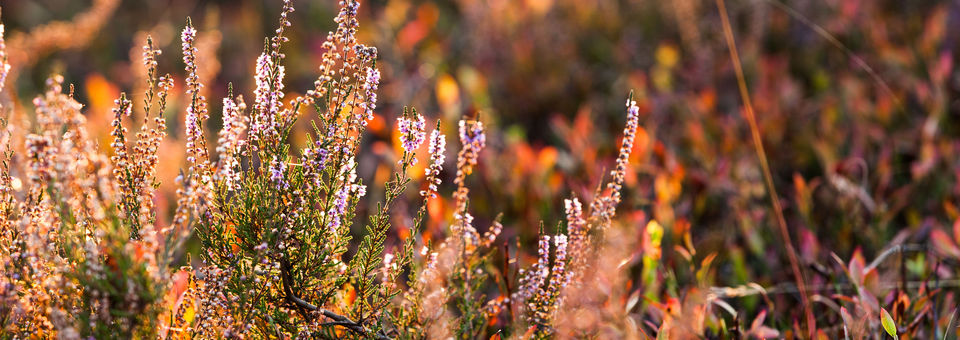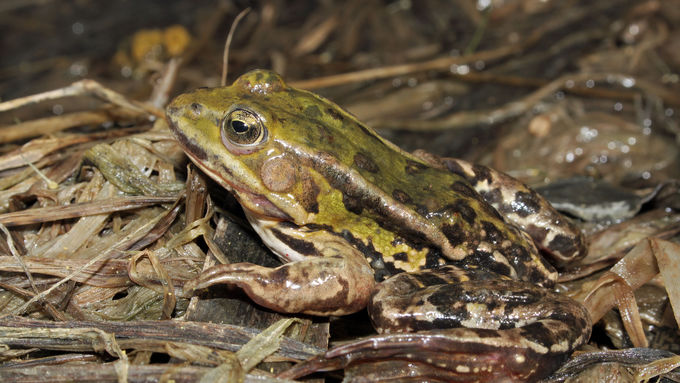Kleiner Wasserfrosch/Pool Frog (Pelophylax lessonae) © Holger Krisp, CC BY 3.0
download picturemain content
Protected Species
PELOPHYLAX (RANA) LESSONAE (1207)
Pool Frog
The Pool Frog is a small water frog with a body length of four to seven centimetres at most. The rarest native water frog species is not clearly distinguishable by external characteristics from the Edible Frog (Pelophylax kl. esculentus [Rana kl. esculenta]) or the Marsh Frog (Pelophylax ridibundus [Rana ridibunda]). The species can only be determined reliably by a complex genetic analysis which is not practicable for use in the field. The animals are usually coloured grass green on the upper side; more rarely brownish, blue-green or light green shades dominate. The back is lined with small, usually blackish spots. Across the middle of the back, there is often a light green longitudinal stripe. On the white belly there are some grey spots. The males are often coloured strikingly yellow during the mating season with whitish resonance pouches.
In contrast to many other amphibians, which only call for mates in the evening or at night, the loud concert of the Pool Frog, as with the other two water frog species, can be heard also during the day due to the almost permanent stay in the water. The mating call of the Pool Frog is quite quiet and a short series of creaking single tones.
Habitat and biology
Compared to its closest relatives, the Pool Frog has not such a close connection to water. Particularly outside the mating season the species is regularly found at a greater distance from waterbodies and also does not avoid forests. Its habitats are alder marsh forests, bogs, wet heaths, swampy meadows and pastures as well as water-rich forest areas. In Lower Saxony, there is a concentration of occurrences on boggy and rather nutrient-poor waterbodies which are not too acidic, such as fen sites. For reproduction, it prefers small to medium-sized stagnant waters with abundant vegetation that are low in nutrients, slightly acidic, exposed to sunlight and without fish, and may be situated both in open land and in the forest. Sometimes the species even occurs in residential areas at backyard waters. The animals colonize the shallow riparian zones for most of the year. The Pool Frog hibernates mostly on land, where it digs into the loose soil in forest areas. Some individuals also spend the winter in the mud at the bottom of the waterbodies.
Already in early spring from March on, the spawning waters are visited. Only at higher temperatures from May on, the actual breeding phase begins, with a main spawning season in May or June. Small to medium-sized egg strings, each containing 100 to 250 eggs, are attached to aquatic plants. The larvae are relatively large (up to eight centimetres), but cannot be distinguished from those of the other water frog species in the field. The young leave the water from the end of July to the end of September. Adult animals look for their terrestrial habitats for hibernation from September. The colonization of new waterbodies probably takes place via subadult frogs. Adult animals are comparatively philopatric and usually have a limited range of only 10 to 150 metres (rarely up to 15 kilometres). Sexual maturity begins after one or two years, sometimes after three years. The life span of the Pool Frog is six to a maximum of twelve years in the field.
Occurrence
In North Rhine-Westphalia, the Pool Frog is classified as "Vulnerable" (VU) and occurs mainly in the lowlands in locations below 100 meters. There have rarely been any known occurrences in the higher areas. Due to the similarity with other water frogs and the difficulties in determining the species, there is little concrete information available about its distribution.
In Lower Saxony, the occurrence of the Pool Frog seems to be extremely fragmented and it is by far the rarest frog species, though there are still very large knowledge deficits. In the Red List of Lower Saxony (2013) the Pool Frog is therefore classified as "endangered with unknown extent” due to the insufficient records. In the north-west of the federal state the species seems to have disappeared completely; in the rest of the federal state there are only a few or sporadically (certainly) proven occurrences. Only in the Weser-Aller Plains the Pool Frog appears to be more common. Due to the fact that the determination of the species under field conditions is very difficult, there are only few reliable data records on their distribution in Lower Saxony.
Threats
Due to the large deficits in knowledge, the general threats for amphibians apply:
- loss or degradation of spawning waters and
- loss or devaluation of meadows, forest glades and bogs in the area around the terrestrial habitat (for example by afforestation),
- change in the water balance in wetlands,
- deterioration of water quality by input of nutrients and pollutants,
- the conversion of grassland into arable land and intensification of grassland use around the spawning areas, and
- the fragmentation of habitats and migration corridors.
Types of action
In principle, the priority should be set on research about the distribution pattern of the species, in order to reduce the lack of knowledge. As long as the real distribution and the preferred habitat are relatively unknown, conservation actions should be based on general protection actions for amphibians. These aim at the preservation, development and, where possible, new creation of spawning waters, the maintenance and development of suitable terrestrial habitat and the improvement of the water balance to stabilise a high groundwater level in wetlands and lowlands. The preservation and development of dynamic floodplains and large wetlands and the creation of retention areas in the flood plains should be targeted in addition to the reduction of nutrients and pollutant inputs in the spawning waters by creating buffer zones. Spawning waters should be without any fish stock or, if possible, fish should be removed in the long term.
Actions within phase 1 of the LIFE IP
In the first phase of the project, two actions which will focus on improving the conservation status of the Pool Frog will be implemented in North Rhine-Westphalia. Both involve the optimisation of a pond or the creation of ponds and spawning waters.
In Lower Saxony, no specific actions under the LIFE IP are planned for the Pool Frog, but synergy effects are to be expected in the implementation of actions for the other focus species and habitat types.
Related Topics
additional information
Further Links
- Species profile „Pool Frog“ – State Agency for Nature, Environment and Consumer Protection (LANUV NRW) (in German) (external link opens in a new window)
- Identification guide for the discrimination of the water frogs (in German) (external link opens in a new window)
- Species profile „Pool Frog“ – German Federal Agency for Nature Conservation (BfN) (in German) (external link opens in a new window)
- German Prioritised Action Frameworks (PAF): Pool Frog, page 130 – German Federal Agency for Nature Conservation (BfN) (in German) (external link opens in a new window)
- Red Lists and complete species list of Amphibians and Reptiles in Lower Saxony and Bremen (NLWKN) (in German) (external link opens in a new window)




